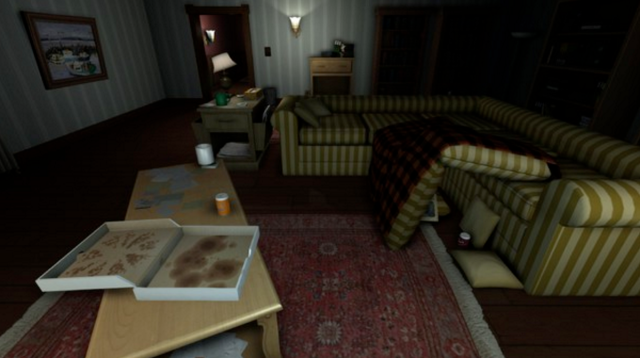When I first played BioShock Infinite, I appreciated the game, but I refrained from analyzing it because it seemed like a game already buried in analyses and discussion. After all, one can hardly finish the game without wanting to analyze it in one way or another. Now, however, I want to offer readers my own discussion of the game, offering an argument that, to my knowledge, hasn’t been advanced elsewhere yet. I want to show you why you, the player, are a crucial element to understanding the narrative of the game, and why your avatar’s name leads you astray from this understanding. Ultimately, I hope to convince you that this makes BioShock Infinite one of the most cohesive and well-crafted works of modern science fiction.
(Be warned: a “spoiler alert” is in effect for the duration of this analysis. The argument probably won’t make much sense unless you’ve played the entire game, anyway.)
In order to do the game justice in this analysis, we’re going to have to start by putting two theories of quantum mechanics on the table: one called the ‘Copenhagen’ interpretation of quantum mechanics, and another called ‘Many-Worlds’ quantum mechanics. If you’re already familiar with these theories, then feel free to skip the first two sections of the article.
A Review of Quantum Mechanics
The Double-Slit Experiment
A huge amount of today’s science fiction tosses around terms like ‘quantum physics’, ‘multiverse theory’, and so on. My contention is that BioShock Infinite succeeds in using actual quantum mechanical theory in developing an impactful and innovative narrative. To see why, we need to explore the bizarre ways in which small particles behave, and how people have tried to make sense of this behavior.[1]
Let’s suppose that we’re shooting small particles—say, electrons—from some device in the direction of a wall. Between the shooting device and the wall is another wall, with two slits in it, so that electrons can only hit the back wall by passing through one of the two slits. The dimensions of the experimental setup are such that there is a chance of the shooting device aiming the electron through either one of the slits, and the back wall has a way of recording precisely where electrons collide with it. Unsurprisingly, this is known as “the double-slit experiment.”[2]
If the electrons behaved like small particles—i.e. small discrete packets of matter, like tiny bullets fired from a gun—then we would expect to observe two discrete bands on back wall, each one corresponding with electrons that went passed through one of the slits on a straight path and collided with the back wall.
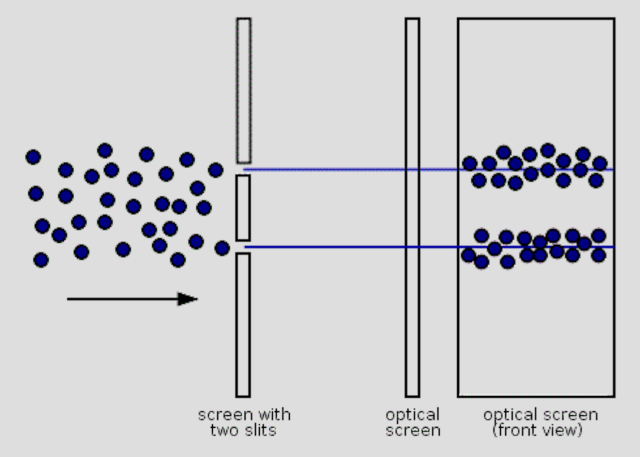
Electrons are fired from a device on the left. Our intuition tells us that each electron will pass through either one slit or the other, resulting in two lines on the back wall (pictured on the right).
But when we run the experiment and then examine the back wall, we don’t see two discrete bands: instead, we see a variety of symmetrical bands, consistent with the idea that electrons are behaving like waves instead of particles: the wave-like electron passes through both slits, interferes with itself, and leaves the distinctive pattern on the back wall.[3] (If you think of each electron like a ripple in a pond, emanating from the shooting device, then you’ll have the right idea as to what this behavior is like.)
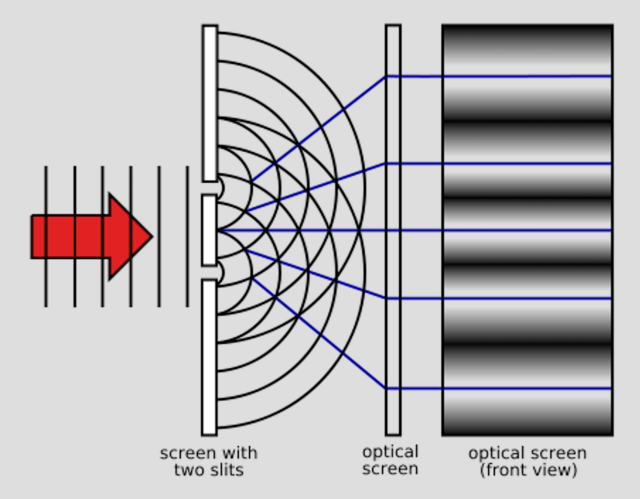
Electrons, illustrated as horizontal waves, pass from the left through both slits at once, interfere with themselves, and generate a pattern of lines on the back wall (pictured right).
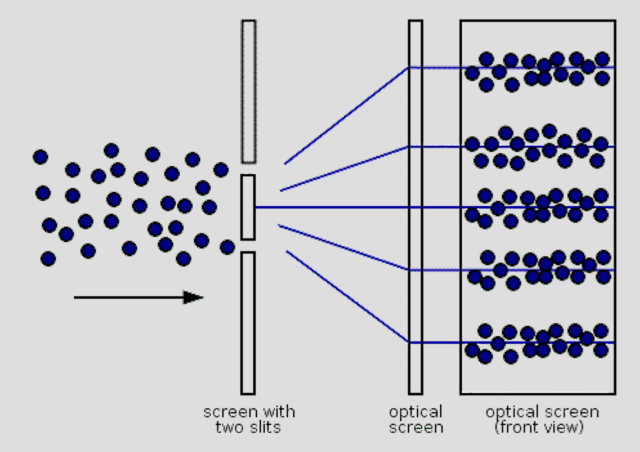
Electrons illustrated as particles, but behaving as waves, as pictured above. You can see here the difference between the actual pattern generated on the back wall and the expected pattern from the first illustration.
So it seems as if these small particles behave more like waves than they do like particles. And in fact, it turns out that we have good empirical reason to believe that the physical properties of these particles can be completely described by functions describing waves—i.e. by ‘wave functions’. This in and of itself is already bizarre: how can a single electron somehow pass through both slits, like a wave? But when we further investigate the phenomenon, things get even more bizarre.
It seems as if a single electron should only be able to pass through one of the two slits at most. So, we could investigate this strange wave-like behavior by placing a detector by the slits, measuring which electrons pass through which slit. And now things get truly strange: when we add a detector in this way, suddenly the electrons do behave like little bullets. The wave-like interference patterns disappear from the back wall, and we see two discrete bands instead.
The baffling conclusion drawn from experiments like this is that small particles behave like waves unless we are able to measure their position, in which case they behave like particles. Particles are in a “superposition” of being in many positions simultaneously (this is the wave-like behavior), until we measure them: then, they appear to determinately be in just one position (in our example, the position of going through one slit or the other)—and it turns out that quantum mechanics can give us extremely accurate probabilities describing how likely it is that we will find a given particle a particular position.[4]
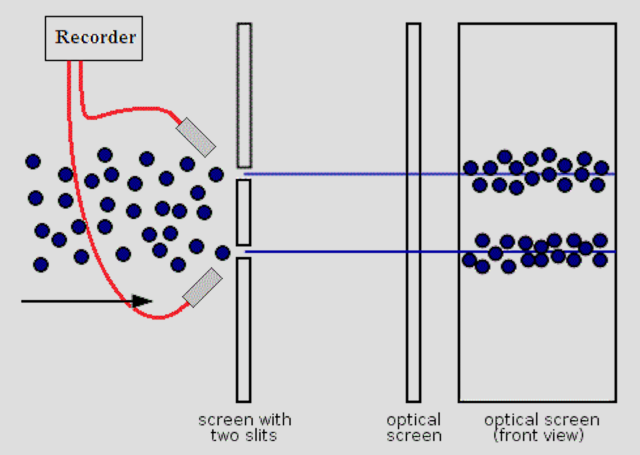
Adding a detector to the experimental setup (labeled “Recorder” in the illustration) yields the experimental results that we expected in the first place (i.e. the results in the first illustration).
How can we make sense of this? It seems like science fiction to say that measuring particles can fundamentally change how they behave—and yet this seems to be how the world really works. And even then, there is another problem: how can we make sense of the fact that we don’t observe the strange dynamics of the double-slit experiment in everyday life? As far as we know, the macroscopic physical world is made up of a (very) large number of microscopic particles, so why doesn’t the behavior of electrons lead to, say, people behaving like waves until someone else looks at them?
There is a variety of ways to resolve these questions. As I said at the outset, we will be concerned with the Copenhagen and Many-Worlds interpretations of quantum mechanics, which answer the questions at hand in different ways. To understand how these interpretations relate to one another, it will be useful to reframe the exact problem that they aim to solve.
The Measurement Problem and Two Potential Solutions
The above quantum mechanical behavior gives us good empirical reasons to believe the following three claims, which cannot all be true at once.[5]
- The physical properties of systems are completely described by their corresponding wave function.
- Wave functions always behave like waves.[6]
- We always see determinate outcomes when measuring physical systems—i.e., when we measure particles, the particles are in a single position, not wave-like superpositions.[7]
The problem that these empirically plausible three claims cannot all be true is called ‘the measurement problem’. If physical systems are all and only waves, then it makes no sense that that they sometimes act like particles instead of waves.
Various interpretations of quantum mechanics aim to resolve the measurement problem by rejecting the truth of one of the above three claims. I will explain, roughly, how the Copenhagen interpretation rejects Claim #2, and how Many-Worlds rejects Claim #3.
The Copenhagen interpretation of quantum mechanics is what most textbooks endorse. It is the view that wave functions sometimes don’t behave like waves—i.e. Claim #2 is not true. Instead, whenever we measure a physical system, its wave function undergoes a “collapse,” resolving its bizarre wave-like superpositions into determinate, singular positions—and which positions the system ends up in are determined probabilistically. So, in the double-slit experiment, when we add the detector to the experiment, there is a 50% probability that a given electron will “collapse” to passing through Slit #1, and a 50% probability that the electron will collapse to passing through Slit #2. And according to Copenhagen, that is all we can say: there is no experimental data available to explain anything about why collapse is something that happens.
Many-Worlds, in contrast, rejects the notion that particles stop behaving like waves when we measure them—i.e. it rejects Claim #3. Instead, it says, we also start behaving like waves when we measure the system. Return to the double-slit experiment. There are two possible definite outcomes to the experiment: either the electron in question passes through Slit #1, or it passes through Slit #2. According to Many-Worlds, when we measure the particle, the particle does not “collapse.” Instead, reality “splits” into two realities: one in which we observe the electron passing through Slit #1, and one in which we observe it passing through Slit #2. Physical systems, on this view, never stop acting like waves: reality just splits at every measurement event, such that every possible outcome is represented in some reality. We never notice this weird wave-nature of the world because we only ever experience one branch of reality at a time.[8] The whole universe, in other words, is wave-like. It is crucial to note that all of these realities are discrete from one another, and it is theoretically impossible for them to ever overlap—if this were not the case, then the theory could not get off the ground in the first place.
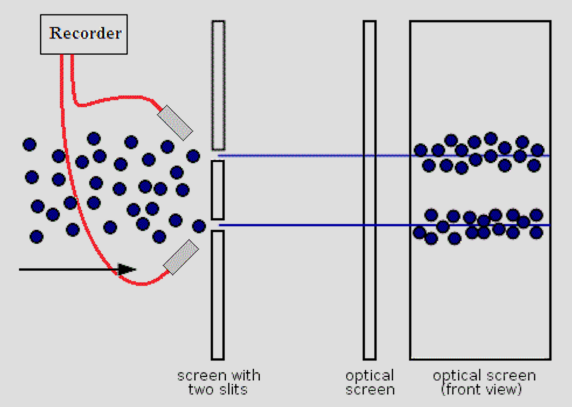
We can understand Copenhagen graphically by supposing that the universe really works the way it appears to in the double-slit experiment: measurement causes wave functions to collapse, yielding singular determinate outcomes.
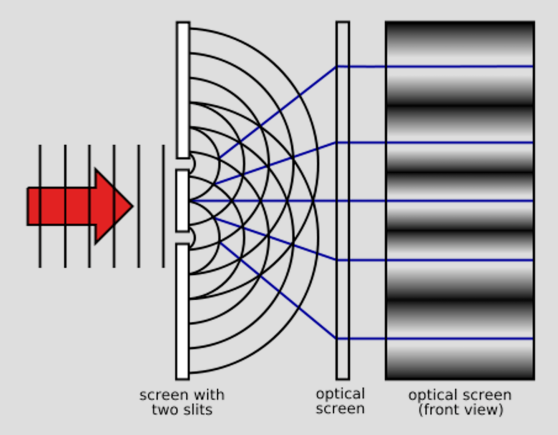
We can represent Many-Worlds graphically, in contrast, by imagining the entire universe as the wave-model of the double-slit experiment. The universe’s evolving wave function leads to a proliferation of realities at each measurement event.
We now have a rough idea of two theories explaining the bizarre quantum behavior of the universe. It is time to see how these theories relate to BioShock Infinite.
Booker DeWitt as a Red Herring
With an understanding of Copenhagen and Many-Worlds in hand, I want to show you why Booker, the avatar and main character of BioShock Infinite, is a red herring in understanding the dynamics of the game’s narrative. I will then show what we gain by moving beyond this red herring and understanding the player as crucial to the game’s narrative.
One thing I neglected to mention above was the history of Many-Worlds as a theory. In 1957, Hugh Everett developed the foundational work that made it possible; however, Many-Worlds itself did not come along until another theorist interpreted Everett’s work as describing a multiplicity of realities. That man’s name was Bryce DeWitt.
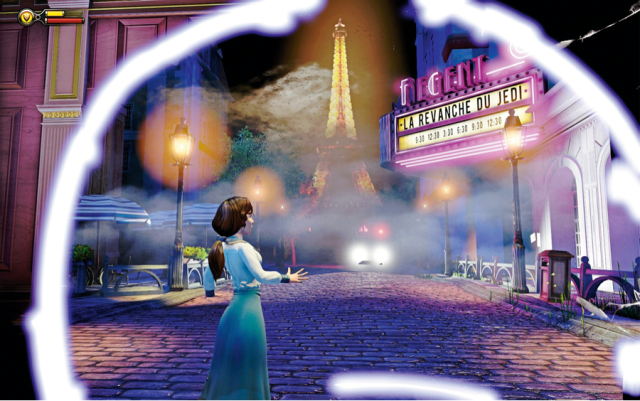
When you’re dropped into a game whose narrative centers on multiple realities, and your avatar is named Booker DeWitt, it should now seem obvious that there’s homage to Many-Worlds at work. I’m nowhere near the first to notice this, to say nothing of the fact that BioShock creator Ken Levine has confirmed it in interviews. So I initially imagined that BioShock Infinite was just very smart, creative science fiction: it’s a period piece in the sense that everything, including the intellectual history, is set in 1912 (this was when the first discoveries in quantum mechanics were happening), and it explores what the universe would be like if Many-Worlds were true and various realities could somehow bleed together.
Of course, there’s a problem with this understanding of the game: as I noted above, it must be the case that each and every reality is non-overlapping in order for Many-Worlds to get off the ground in the first place. If the realities could interact, then the theory could not be tractable at all. So if we look at BioShock Infinite in this way, then we have to accept that its science fiction, period-piece accurate though it may be, is much more fiction than science—and it becomes obvious why it is so difficult to make sense of sequences of events and causation between different realities. I would go so far as to say that the game, in this context, ends up being more fantasy than science fiction.
However, I realized that there’s another way to view the dynamics of the game’s science that makes its science fiction much more science than fiction—it just requires moving beyond Booker’s last name, and recognizing the role of the player in the game’s story.
Collapse in Video Games
Regulars to With a Terrible Fate will be familiar with my argument that we often need to recognize the player of a video game as an element of the game’s narrative in order to adequately understand the game. I originally called this thesis the ‘Majoran Critique’ because I first discussed it in my analyses of Legend of Zelda: Majora’s Mask; I later argued that we also need this thesis to make sense of Xenoblade Chronicles, because the player’s agency is the only way to make sense of the main character killing an omniscient god. Once we apply this thesis to BioShock Infinite, we can see that the Copenhagen interpretation is actually just as relevant to the game as Many-Worlds is—and this reformulation of the game renders it one of the most cohesive and well-crafted works of modern science fiction.
What would happen to the universe if someone observed it from the outside? In our own world, from a scientific perspective, this is practically a nonsense question: if we conceive of the universe as all time and space, then it doesn’t seem as if anything can be meaningfully “outside” of it. But we can easily explore this sort of question in video games, because video games present discrete worlds and universes—the player looks on these worlds and engages them from the outside. The world of a game is confined to a computer system, which the player can engage and influence. And so they present an opportunity to talk meaningfully about someone observing a universe.
If we think of the player as an observer of the universe of a video game, then we can think of the video game’s universe as analogous to the double-slit experiment: the contents of the universe are in superposition of many different outcomes until the player engages the game, thereby “measuring” the system. And when measurement happens, we have the same choice of theories by which to make sense of what happens.
I think that a standard Copenhagen interpretation of quantum mechanics is especially useful for making sense of video games as a medium in this regard. This is a useful interpretation to choose because it reflects how players actually engage video games. Prior to player input, the worlds of video games are mere potentialities, a variety of disparate outcomes encoded by the game’s program; but when the player engages the game “from the outside,” a single, determinate series of events emerges as output, which the player observes as the game’s narrative. Out of superposed potentials, one coherent world emerges—a phenomenon very similar to collapse. Of course, there are obvious differences between this phenomenon and collapse—in particular, it is not clear how probabilities figure into the engagement of players with video games—but for aesthetic purposes, this is sufficient to make video games a uniquely well-suited medium for quantum-mechanical science fiction. This, we will see, is the grounding for why BioShock Infinite is a remarkable work of art.
Understanding BioShock Infinite as a Metaphor for Collapse
BioShock Infinite’s story is difficult to understand because, as Ken Levine himself has noted in an interview with Forbes, “Our brains are not really designed to understand [quantum mechanics], and even having gone through a game where I’ve researched this […] it’s still something that challenges your brain in a way that few scientific notions can.” The story is derived from a conflict between Booker DeWitt and Zachary Hale Comstock, two different versions of Booker derived from whether or not Booker chose to be baptized in a quest for redemption for his actions at The Battle of Wounded Knee; using technology that allows for communication and travel between realities (developed by the Luteces), various versions of Comstock seek world domination and kidnap the daughters of various Bookers to serve as their heirs (Comstocks are sterile due to overuse of reality-traversing technologies). Ultimately, the only way for the struggle across infinite realities to end is for Booker to be annihilated at the moment of his choice to be baptized or not: Elizabeth, his/Comstock’s daughter with the capacity to traverse realities, drowns him in the baptismal waters, effectively preventing him from bifurcating into infinite Bookers and infinite Comstocks. After Booker drowns and the game’s credits roll, a scene plays of Booker waking up in his office in 1893, calling out to Anna (his daughter), and walking into a room with a crib before the screen fades to black.
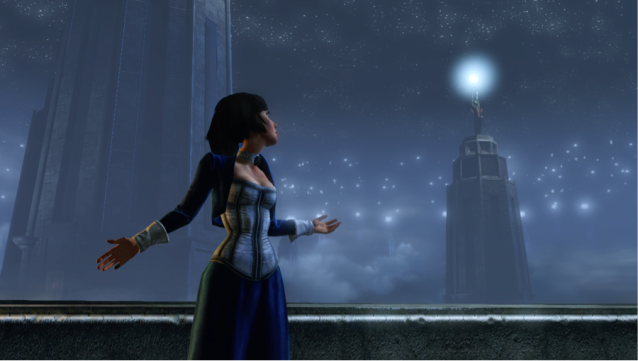
There are myriad problems with understanding the whole of this narrative in a purely Many-Worlds context. First, as I mentioned earlier, the very notion of disjunctive realities existing as a result of quantum mechanics can only get off the ground if those realities never overlap or intersect. But even if we allow for communication between realities, narrative issues remain. How can we make sense of the passage of time and events within a single reality if they are coextensive with time and events from another reality? And, similarly, how are we to make sense of causation in this context? It is hard to make sense of questions such as these, let alone answer them, because it is not obvious how to parse time-dependent claims when they involve the fundamental constituents of reality being modified. And this is to say nothing of the fact that, if Elizabeth was successful at the end of the game and truly annihilated Booker at the moment of potential baptism, then the entirety of the game narrative that the player just completed would never have existed. This is not to say it would have simply been “just a dream,” or an illusion—it literally would never have obtained within the game’s universe, by stipulation of the game itself. To paraphrase Levine, our brains are not designed to think about things in this way.
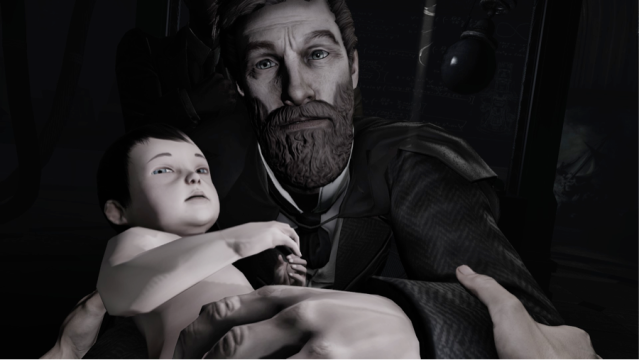
You might object that I am being obtuse and not playing the game by its own rules; it is, after all, science fiction, and you can question its scientific dynamics just as much as you can question those of any time-travel story or multiverse story. It is better, you might argue, to appreciate the tremendous artistic merit of the game’s world, characters, and story, without pressing its overall coherence. But the only point I am driving at here is that it is extremely difficult to make sense of the entirety of BioShock Infinite’s narrative if we understand it, as people typically have, in terms of Many-Worlds. Praising how much the game makes us contemplate questions of free will and choice will do nothing for us here: the problem is our basic conception of its universe, on the level of scientific law. So if there is an alternate interpretation available to us that allows us to make better sense of what is going on, then we ought at least to seriously consider the merits of that interpretation. I contend that a collapse theory is just such an alternate interpretation: in particular, I think that we ought to conceive of BioShock Infinite’s narrative as a metaphor for quantum collapse, in the Copenhagen sense of ‘collapse’.
On the Copenhagen interpretation of quantum mechanics, collapse of wave functions happens when measurement occurs—and that’s all that we can say about it. But what if we could tell a story about this phenomenon? What if we put characters and events to the notion of a system being in many different positions collapsing into a single, determinate position? This would be an artistic exploration of a real, scientific process—collapse—and it would also defy our traditional notions of narrative because the scientific process being explored has yet to actually be explained. This is precisely what we see in BioShock Infinite. The player encounters a universe with many possible series of events—many possible realities—and by engaging that universe—by playing the game—the player causes the universe to collapse from a superposition of realities into a singular, determinate reality: the scene presented at the end of the game. Recall that the question of which position a system in superposition will collapse to is probabilistic. This, on my interpretation, is why the last scene is so vague as to which reality it is: the game itself reflects the fact that the final, determinate reality could be an infinite number of the prior superposed realities, and which particular reality has been made determinate is fundamentally a matter of chance. The game’s narrative, beautiful as it is, puts a story to the confused, inexplicable collapse of disjunctive, entangled realities into one determinate reality: we do not need to make sense of things like time or causation within the story because the story is a metaphor for the instantaneous annihilation of all but one component of the universe’s superposition.
This analysis allows appreciators of BioShock Infinite to engage the story while also making sense of its world’s scientific dynamics. In so doing, we can avoid the analytic pitfalls of the approach that ignores the player and instead conceives of the game’s universe using a Many-Worlds interpretation alone. But the analysis has another benefit beyond this: it allows us to see clearly a special insight that BioShock Infinite provides into the aesthetics of quantum mechanics.
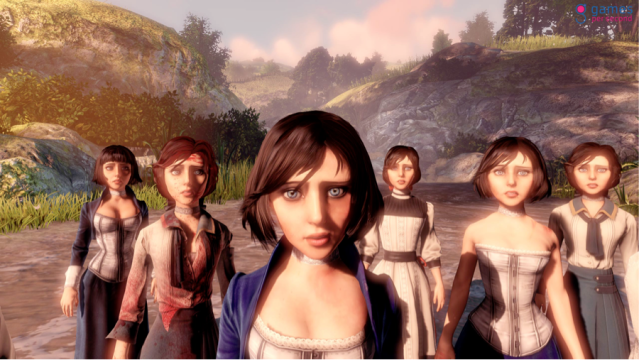
Now that we have moved beyond the red herring of Booker’s last name, it is time to return to it. There is something very Many-Worlds-esque about BioShock Infinite, although we cannot make sense of its universe using Many-Worlds alone. Until collapse happens, its universe is in a superposition of multiple, discrete realities—and this could be likened to a Many-Worlds universe. Note that we never see this universe in the game: by stipulation, this is impossible, because our engaging the game’s universe causes it to collapse. This universe would not feature an Elizabeth who crossed over realities, since each reality is discrete, but it would presumably be populated by a variety of Comstocks and Bookers in various realities. And this allows us to notice something illuminating: if we consider a universe in conjunction with an observer external to that universe, then there is a way in which we can contemplate a combination of Many-Worlds and collapse dynamics: the universe alone, in superposition, can look like a collection of disjunctive realities—but, in virtue of the outside observer, we could imagine there being collapse dynamics such that the observer causes all but one of those realities to vanish by measuring the universe. When the subject of inquiry is our actual universe, this notion makes little sense; yet BioShock Infinite shows that exploring conjunctions of quantum theories such as this is both possible and compelling in the arts.
I agree with the popular sentiment that BioShock Infinite is one of the most compelling story-based video games in recent years; I also believe that it has set a new standard for cohesive, well-crafted science fiction. By making use of the dynamics of video games as a representational art form, the game manages to take real quantum mechanical theory and philosophy as a basis for its elaborate storyline. It allows us to imagine collapse as an emotional, human experience, in which our various identities, desires, and potentials violently resolve in an instant.

[1] This is a simplified explanation of quantum phenomena. For a more involved introduction to the same concepts, I recommend David Z. Albert’s Quantum Mechanics and Experience (1992), or Richard’s Feynman’s “Quantum Behavior” from his Lectures on Physics (1964).
[2] A more thorough and technical discussion of the double-slit experiment can be found in Feynman, ibid.
[3] This is an oversimplification and technically wrong. It is more accurate to say that the electron passes through Slit #1, Slit #2, both slits, and neither slit, all simultaneously—but that is beyond the scope of this article.
[4] These are the probabilities given by Born’s Rule.
[5] I borrow the general structure of this formulation of the measurement problem from Tim Maudlin’s “Three Measurement Problems,” Topoi 14: 7-15, 1995. This is what Maudlin refers to as ‘the problem of outcomes’.
[6] More precisely, wave functions always obey linear dynamics.
[7] More precisely, linear dynamics are violated when we measure physical systems.
[8] Of course, if we measure something and reality splits, then versions of us exist in both resulting realities—and so it is not obvious how to parse the meaning of “we” in this sentence or in Many-Worlds more generally. The point is simply that our conscious experience, what it may ultimately amount to, seems to only ever engage one branch of reality at a time.















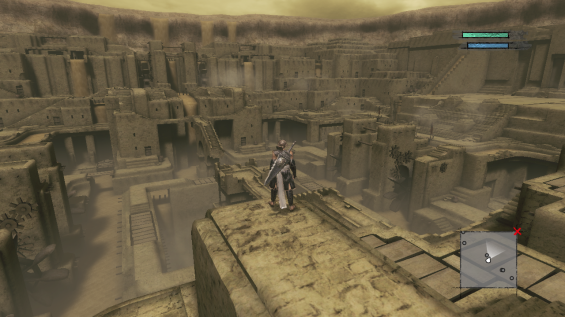
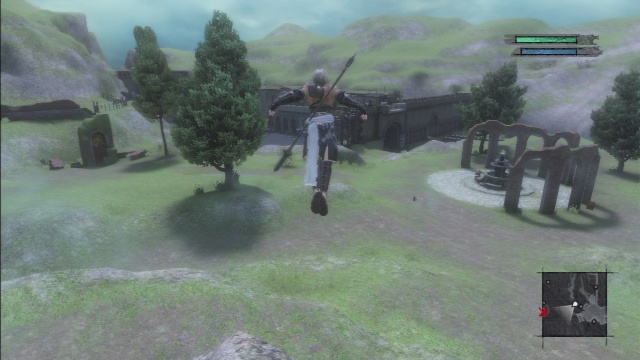

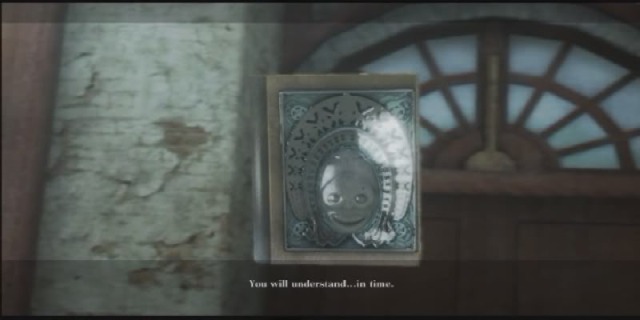
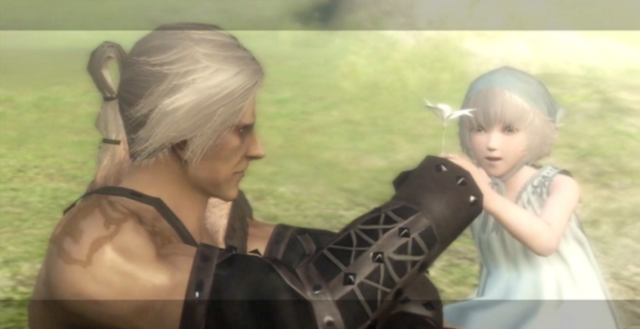


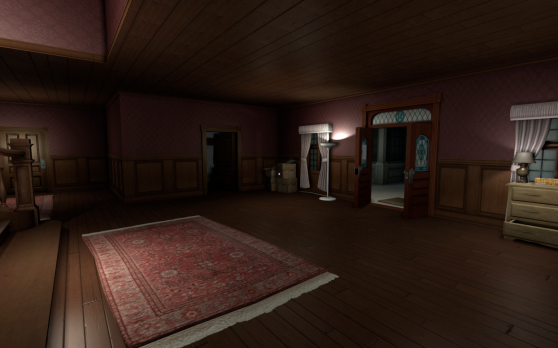
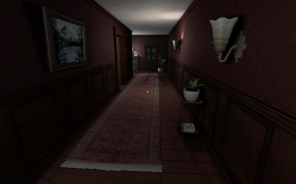
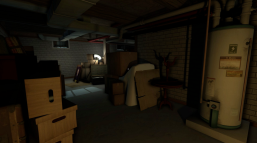
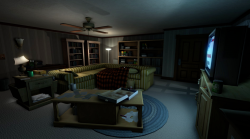 In
In 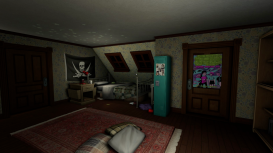 Aside from the diary notes, players are left to extrapolate meaning from character’s objects on their own accord. For instance, upon scrutinizing one of Samantha’s soccer trophies, I wondered whether or not she actually liked soccer. Initially, I imagined her as being a sort of jock…until I discovered her mix tape of grunge music in her deeply private, secretive room, suggesting she was a recluse. She was now the angsty girl who rebelled against her parents’ image of her as a conformist extrovert. That the trophy was displayed in the living room, rather than kept in her room with her most treasured objects, is a testament to the level of care Fullbright took in designing this world. Players use not only objects, but also their placement, condition, color, etc. to dynamically mold their interpretations of these characters and their story. Every unchecked corner and quick glance is a missed opportunity, another hole in this home that feels inhabited by real people. One of my favorite details, which spoke to my inner 90’s kid, was discovering a television room with VHS recordings labeled “X-Files.” The couch cushions are fashioned into a fort, where we assume young Sam and company were staying up past their bedtime to indulge in Mulder and Scully’s sci-fi escapades. It is rare to see a world crafted with such care in every inch of its body. Personally, the two hours spent interacting with this world were more intellectually and emotionally rewarding to me than most 80+ hour open-world experiences available today.
Aside from the diary notes, players are left to extrapolate meaning from character’s objects on their own accord. For instance, upon scrutinizing one of Samantha’s soccer trophies, I wondered whether or not she actually liked soccer. Initially, I imagined her as being a sort of jock…until I discovered her mix tape of grunge music in her deeply private, secretive room, suggesting she was a recluse. She was now the angsty girl who rebelled against her parents’ image of her as a conformist extrovert. That the trophy was displayed in the living room, rather than kept in her room with her most treasured objects, is a testament to the level of care Fullbright took in designing this world. Players use not only objects, but also their placement, condition, color, etc. to dynamically mold their interpretations of these characters and their story. Every unchecked corner and quick glance is a missed opportunity, another hole in this home that feels inhabited by real people. One of my favorite details, which spoke to my inner 90’s kid, was discovering a television room with VHS recordings labeled “X-Files.” The couch cushions are fashioned into a fort, where we assume young Sam and company were staying up past their bedtime to indulge in Mulder and Scully’s sci-fi escapades. It is rare to see a world crafted with such care in every inch of its body. Personally, the two hours spent interacting with this world were more intellectually and emotionally rewarding to me than most 80+ hour open-world experiences available today.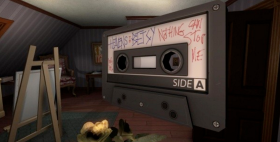 Fullbright designed a fleshed-out world in this entity of a house, but its surface-level narrative – uncovering the reason behind the family’s absence – has been one of the game’s more contentious elements. It is difficult, and perhaps beside the point, to criticize a story such as this, especially when so much is contingent upon what the player has and has not seen in this world. Even more difficult is guiding the player to important plot points. Whether that point be a characterizing object in
Fullbright designed a fleshed-out world in this entity of a house, but its surface-level narrative – uncovering the reason behind the family’s absence – has been one of the game’s more contentious elements. It is difficult, and perhaps beside the point, to criticize a story such as this, especially when so much is contingent upon what the player has and has not seen in this world. Even more difficult is guiding the player to important plot points. Whether that point be a characterizing object in 